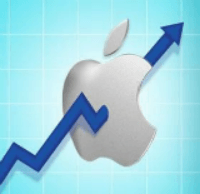The From Line
 iPad passes Mac computer in sales. The tablet is the new frontier.
iPad passes Mac computer in sales. The tablet is the new frontier.
It’s official. Consumers are tablet crazy; so much so that they are choosing the mobile devices over computers. It’s that time again marketers, just when you’ve finally optimized for mobile…
A look into Apples record breaking year provides an impressive example of the tablets’ rapid rise in popularity. In 2011, the company sold over 156 million iOS devices (iPhone, iPad, and iPod Touch), 55 million of which were iPads. To put this in perspective, in just one year combined sales of these mobile devices have exceeded the 122 million Mac computers ever sold. Since it was first available for pre-order in March of 2010, the sales trend of the iPad has blown all other Apple products out of the water (see figure below). CEO Tim Cook commented “This 55 is something no one would have guessed. Including us. To put it in context, it took us 22 years to sell 55 million Macs. It took us about 5 years to sell 22 million iPods, and it took us about 3 years to sell that many iPhones. And so, this thing is, as you said, it’s on a trajectory that’s off the charts.” There has been buzz for some time of the possible upcoming announcement of the iPad3, and today we have verification via Mashable that Apple has sent out invitations for an event on March 7th. The invitation states simply “We have something you really need to see. And touch” and according to Mashable is "superimposed on what is almost certainly an iPad". Knowing this, it is more crucial than ever for marketers to take to heart the magnitude of this trend. It has been rumored that the newest generation iPad will have a full operating system, providing the user with a full blown hand held computer, and conceivably further intensifying this trend. Yes, Apple is just one example, but I think it’s safe to say they are usually ahead of the trend. Assessing how we communicate via tablet will be paramount.
 Google recently announced a change in their privacy policies. The new format will combine existing privacy policies into one, gathering customer data from all of its services including search, Gmail, YouTube, Google+, and Google Docs. Essentially Google is making a move to be more competitive with the likes of Facebook who has been collecting a wider spectrum of data while providing its customers a more personal experience. Having a unified privacy policy that applies to all products will allow for data integration across multiple mediums and will improve the personalization of a user’s experience. So what does this mean for marketers? Overtime customers will become desensitized to such policies as the all inclusive privacy model becomes the norm. Google is leading the way and opening the flood gates for other marketers to revamp their privacy policies as well.
Google recently announced a change in their privacy policies. The new format will combine existing privacy policies into one, gathering customer data from all of its services including search, Gmail, YouTube, Google+, and Google Docs. Essentially Google is making a move to be more competitive with the likes of Facebook who has been collecting a wider spectrum of data while providing its customers a more personal experience. Having a unified privacy policy that applies to all products will allow for data integration across multiple mediums and will improve the personalization of a user’s experience. So what does this mean for marketers? Overtime customers will become desensitized to such policies as the all inclusive privacy model becomes the norm. Google is leading the way and opening the flood gates for other marketers to revamp their privacy policies as well.
Takeaway: The winners will balance privacy with increased value through personalization.
In order to make this work to your advantage, you will need to reassess your privacy policies and find a balance that customers are comfortable with. Most privacy policies were created between 2001 and 2005 when the public was still sensitive about this subject and therefore are due for a makeover. However, in order for a revamped privacy policy to provide balanced benefits, it must be carefully tailored to fit the behaviors and comfort levels of its customers. You will need to dig into your existing policies and adjust accordingly.

28% of Americans are using mobile and social location based services for everything from driving directions to dinner reservations.
 I must say I was surprised to read that only a quarter of us are gathering information through location based searches, mostly because I cannot imagine a day where I myself could be without that mobile connection. Personal preference aside, consumer usage of LBS’s is on the rise. We can now accomplish just about anything as long as we have a cell signal or wifi. Essentially we have been afforded the opportunity to be mobile powerhouses on a hyper local level. I can get step by step directions to that obscure sushi joint for a business lunch and locate the closest pharmacy that carries a very specific flavor of Tums, all while booking a romantic ski getaway, complete with nightly dinner reservations. And that was just between metro stops. Consumers are becoming increasingly needy and will continue to interact with LBS’s that play to that trait. It is no longer enough to base purchasing decisions off testimonial information. We want the best of the best, that’s right down the block, and we want it discounted.
I must say I was surprised to read that only a quarter of us are gathering information through location based searches, mostly because I cannot imagine a day where I myself could be without that mobile connection. Personal preference aside, consumer usage of LBS’s is on the rise. We can now accomplish just about anything as long as we have a cell signal or wifi. Essentially we have been afforded the opportunity to be mobile powerhouses on a hyper local level. I can get step by step directions to that obscure sushi joint for a business lunch and locate the closest pharmacy that carries a very specific flavor of Tums, all while booking a romantic ski getaway, complete with nightly dinner reservations. And that was just between metro stops. Consumers are becoming increasingly needy and will continue to interact with LBS’s that play to that trait. It is no longer enough to base purchasing decisions off testimonial information. We want the best of the best, that’s right down the block, and we want it discounted.
 ncreasing Email Relevancy with Social Data
ncreasing Email Relevancy with Social Data